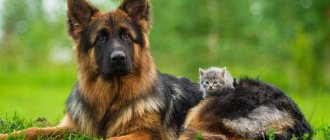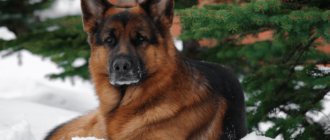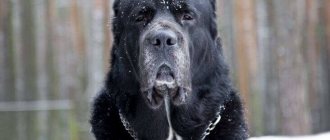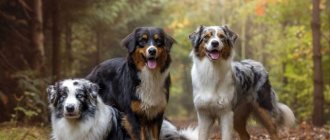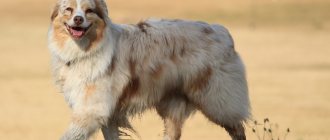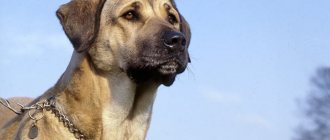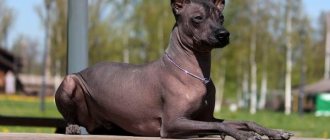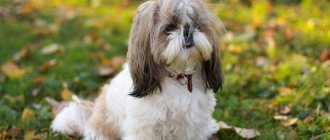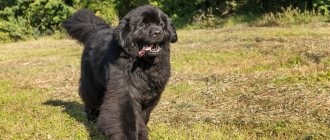Description and features
Bergamasco Shepherd Dogs were created to help people and carry out serious and responsible work. Their profession is a herding and guard dog. They look like real rural dogs, their category is “pastoral”. This breed cannot be confused with any other; its appearance is too exotic. The animal is built harmoniously and firmly, of medium height, in boys at the withers - 60 cm, in girls - 56 cm.
A difference of 2 cm is allowed, both plus and minus. Looks muscular, heavy bone. The weight of a female is 26-32, a male is 32-38 kg, although because of their clothing they seem heavier. Since this breed is standardized, we will describe some of its characteristics:
General form:
Powerfully folded, compact in profile, slightly longer than tall. Rectangular format. The skin is tight, densely covered with hair.
Options:
- Head: The length of the head is 2/5 of the height of the dog at the withers. The muzzle and skull are the same length, so the length of the muzzle should be almost half the length of the head. Wide skull, slightly convex between high-set ears. The forehead is rounded. In profile, the top of the skull and the top of the muzzle are parallel. The width of the head is no more than half the length from the back of the head to the tip of the nose. Slightly protruding nape. The truncated muzzle tapers slightly towards the nose, but does not become very pointed. The frontal part is quite flat.
- Nose: The wet nose should only be black.
- Jaws: Strong, with a scissor bite. The lips are tightly pressed, well pigmented and cover the front of the jaw. The upper teeth overlap the lower teeth and fit into the jaws.
- Eyes: oval, large, dark chestnut color preferred, but usually depends on coat color. Blues are not allowed. A soft, calm and attentive expression. The rims of the eyes are black, the eyelashes are long.
- Ears: Set high, triangular in shape with slightly rounded tips. Covered with soft, slightly wavy hair.
- Neck: medium length, strong, slightly arched. All covered with dense wool. Smoothly transitions to high withers.
- Legs: Straight, with strong bones and muscles, paws oval with well-closed and arched toes. Nails are dark.
- Body: the length of the body (excluding the head and tail) is equal to the height at the withers. The wide back has a straight line, the croup is sloping. The chest is medium, the back of the thighs are wide and muscular.
- Tail: Quite long, reaching to the hock joint, wide at the root, tapering downward and curved at the end. When moving, it sways like a flag in the wind.
- Finally, and most importantly, wool:
It is unique, with hair of three different textures: undercoat, goat hair and long guard hair. The undercoat is short in length, fine in structure, dense and waterproof, and feels greasy to the touch. “Goat” hair is quite hard, straight and long. The longest outer hair, unlike the previous layer, is soft and thin.
The unusual fur makes it difficult to see the dog's face
Together they form loose layers, similar to felt mats. They cover the face, body, and legs. This coat protects the dog well from bad weather and predators. The hair on the head is long and usually falls over the eyes.
The Bergamasco Shepherd in the photo evokes the feeling that the dog has “dressed up” in heroic armor made of hard plates. Only this shell is of natural origin, it is made of wool.
Kinds
Like any standardized breed, the Bergamasco has no species. In this case we are talking only about colors. It is allowed in these dogs of all shades of gray; white is considered a defect. The color can be solid gray, it can be spotted in all shades from gray to black, including marble and silver.
These are the colors of the Bergamasco Shepherd
White spots are possible in no more than 1/5 of the total wool volume. Allowed colors are black (matte, no shine), black and brown, Isabella (pale straw), light fawn (light fawn or light red), merle thrush (leopard).
History of the breed
The Bergamasco Shepherd breed dates back to ancient times. At least, the first mentions of very shaggy guard dogs are found in some Roman documents about 2000 years ago. Despite such a long pedigree, very little is known about their origins.
Therefore, there are several versions of her birth. Some suggest that its ancestors were Tibetan mastiffs, and they, along with the Huns from Asia, gradually moved to Europe. Others believe that Bergamascos are descended from Briards (one of the 14 breeds of French shepherd dogs). There is also a third version.
Rich merchants and sailors from Phenicia, who intensively established trade with other countries, supplied Europe with beautiful fabrics, spices, and slaves about 2000 years ago. They were the first to bring large and shaggy dogs.
Their first habitat was Tuscany, where the Maremma breed appeared (a shepherd dog with shaggy hair of an exceptionally light color, originating from the Italian regions of Maremma and Abruzzo). Then they gradually occupied the north of Italy, where the Bergamasco breed began its pedigree.
It was named after the city of Bergamo, where the first breeders of such dogs appeared. From here, the Phoenician descendants spread to Europe, penetrating Spain and France, where they served as the starting point for the creation of new wonderful breeds. One way or another, the targeted breeding of herding shepherd dogs began in Lombardy, in the city of Bergamo.
At the end of the Second World War, the breed was in a deplorable state, it virtually disappeared, but the Italian dog handler and breeder Mareo Andreoli took up the task of restoring it. Fortunately, he successfully completed this task. However, to this day the Bergamasco is considered a rather rare breed.
Brief historical background
Bergamascos are classified as so-called shaggy shepherd dogs, whose ancestors are considered to be Tibetan shepherd dogs. Distant ancestors most likely came to Europe through China and Central Asia along with wandering Phoenician traders or nomads more than two thousand years ago. As a result of crossing with local herding dog breeds, shaggy shepherd dogs appeared in the form in which we know them today.
The greatest concentration of these dogs was observed in the Italian province of Bergamo, which was one of the main centers of cattle breeding in Italy and gave the name to the breed. Over the course of many centuries, individuals with the best working qualities have been painstakingly selected under conditions of harsh natural selection. Purposeful breeding of these shepherd dogs began only towards the end of the 19th century.
In Italy, Bergamascos still herd sheep to this day.
The world canine community recognized the breed in 1959, at the same time the first breed club was founded, and a preliminary breed standard was described and approved. In the FCI registry, the Bergamasco Shepherd Dog is listed in group 1 - herding and cattle dogs (section 1 - shepherd dogs) under number 194. The latest current edition of the standard is dated June 1, 1992.
Character
Even the character of this breed must correspond to the standard. Characteristics of the Bergamasco Shepherd: A vigilant guard with a strong protective instinct. Temperament: smart, careful, patient. A good companion, guard.
Indeed, Bergamasques are loyal, loving, trainable animals, vigilantly watching over those they love. The character is flexible and good-natured, decisive but cautious. The Bergamasco Shepherd dog loves children and is loyal to other animals. He tries not to enter into open conflict.
However, she can stand up for herself if something seems aggressive to her. Always willing to please, smart, dedicated. Patient and faithful protector. Affectionate, faithful, not capricious. He is wary of strangers, but does not show aggression unnecessarily.
The Bergamasco Shepherd looks like a cloud when running
She has partially retained echoes of her harsh disposition, but she adores her owner and obeys him unquestioningly. By the way, her submission is a completely conscious act; she does not submit, but shows her love for you. There is a note of independence and stubbornness in the character - from mountain dogs.
If you train from an early puppyhood, you can overcome this stubbornness and get an obedient and well-mannered pet. As already mentioned, their task is to herd and protect the flock. Bergamascos love to work and have an excellent memory.
They enjoy watching the herd, do it energetically, and are not afraid of any weather. They have a wonderful sense of smell and hearing. Bergamasco can be used to protect any territories and objects; they are reliable assistants and rescuers in case of fires and other natural disasters.
Intelligence, ability to react quickly, patience and stable behavior make these dogs irreplaceable companions, guards and even family members. The Bergamasco Shepherd is a versatile breed and they are capable of achieving a lot. All their wonderful qualities must be nurtured, and the pets themselves must be trained.
We must try to find a common language with the dog and become its unquestioning leader. It is better if you contact an experienced trainer, especially if you have no experience in training such animals. Mistakes in upbringing and training made early on are very difficult to correct later.
In their opinion, a family is a flock, it must be protected and protected. There is only one leader of the pack - the beloved owner. She will take care of the remaining members, protect them, and even act as a nanny. They have humor and slyness and can support any game or prank.
Socialization
Socialization includes a number of activities aimed at developing an adequate attitude of a puppy, and in the future an adult, to the environment and objects:
- Socialization with other dogs. The first people a puppy comes into contact with are its mother and brothers and sisters. In games, children learn to measure the force of their bite and develop a certain model of behavior. As the puppy grows, it is necessary to visit puppy pads, which is useful for gaining experience in communication.
- Socialization in relation to a person. The more contact the baby has with a person, the faster he adapts to new living conditions. If his permanent place of residence is the countryside, and the dog sits behind a high fence, not seeing anyone, then he may grow up shy. In order to prevent such a situation, it is necessary to take your growing baby for walks in crowded and noisy places.
- Socialization towards other pets. Often other animals live in the house on the same territory as the little Bergamese. The Bergamasco dog does not have a very warm attitude towards its competitors; the first acquaintance will more likely evoke a feeling of curiosity than a desire for leadership in the family. It is necessary to give time for the animals to get used to each other. The owner must simultaneously demonstrate his love for each of them.
Early socialization will help raise a problem-free and obedient pet.
Sociability of the breed
The Bergamasco Shepherd gets 10 points out of 10 for sociability. He loves all the members of his flock without exception, including children, cats, geese, sheep - absolutely everyone.
Bergamasco adores his owner and is very friendly to all family members and other pets.
She is indifferent to strangers, does not show aggression, but will not be affectionate. She is not prone to fights with other dogs, the Bergamasco is too confident in herself, she does not need self-assertion in fights.
Security qualities
Outside its territory, the Bergamasco does not show aggression and is unlikely to become a professional bodyguard. But in an emergency situation, he will come to the defense of his beloved owner.
Reference! Historically, the Bergamasco Shepherd sometimes had to serve as a guard dog. Drive away wolves and other wild animals from the grazing herd.
There is an instinct to protect the territory. With proper training, he will definitely be able to carry out the security function of a house and property without the owner’s command.
Key points in education
It is worth noting that the Bergamasco can show remarkable stubbornness when trained. You need to be able to come to an agreement with him, find good motivation, then the dog will happily follow commands.
You need to start training from early childhood, this will several times increase the chances of getting a truly controllable dog. All training must be based on positivity, otherwise the Bergamasco Shepherd may refuse to train at all.
We recommend reading: Wolfdog - characteristics and features of the breed
When cruel methods of punishment are demonstrated, representatives of this breed can respond to aggression with aggression. Bergamasco is close in character to the natives, and will not allow himself to be offended.
Nutrition
Bergamasques are unpretentious in their choice of food. However, the diet must fully correspond to physical needs. They can eat both natural food and ready-made food for active dogs.
Ready-made food must be purchased at veterinary pharmacies or specialized stores; it must be “premium class” or “holistic” (based on natural ingredients). As with other pet dogs, natural food should rely on five main basic components:
- Proteins (lean meat and fish).
- Fats (lactic acid products and vegetable oil).
- Carbohydrates (porridge from buckwheat, rice, millet, a small amount of durum wheat pasta).
- Fiber (fruits, vegetables).
- Vitamins and mineral supplements.
It is strictly forbidden to give harmful “snacks”: smoked foods, various sweet things, fatty and salty foods, and also legumes. The daily diet consists of 30% proteins. Babies should be fed small portions 3-4 times a day. Adult dogs are fed twice a day.
If you're having a girl, be aware that she may lose her appetite when she's in heat. Don't be alarmed if she refuses to eat. Just feed her less often, once a day, and reduce the portion a little. Then everything will be restored.
Calorie intake also needs to be regulated, after all, this is a free-willed dog, it must be constantly in active movement. If there is no decent outlet for energy, she gets fat and loses interest in life. It is better to consult with a specialist on how to correctly calculate the calorie content of food. An indispensable condition is always fresh water in a bowl!
Characteristics of the Bergamasco Shepherd
| Attachment level | High |
| Friendliness | High |
| For children | High |
| Loyalty to other pets | High |
| Exercise needs | Average |
| Playfulness | Average |
| Energy level | Average |
| Learning ability | Average |
| Intelligence | High |
| Tendency to bark | Average |
| Shedding amount | Short |
Reproduction and lifespan
The girl is prepared for mating after the second, or preferably the third, heat, at about the age of 2 years. The event usually takes place on the territory of the male dog; it is more convenient for him to be in his own environment. The dog bears offspring for 61-64 days. Usually 6-8 puppies are born, which are immediately visible with soft and curly fur of medium length.
In the first years of life, it is lush, then it begins to take on a matted appearance. These babies need a little more time to adapt than other breeds. Therefore, it is better to pick up a puppy no later than 3 months old.
Mother with Bergamasco Shepherd puppies
Bergamasco Shepherd puppies are distinguished by their intelligence and intelligence from an early age. They need to be trained only on the basis of trust, respect, fairness, firmness and consistency. It is advisable to take your puppy through a course of general training and basic socialization.
At the age of 1.5-3 years, the puppy resembles a shaggy brownie. It’s not for nothing that people call them “demons”! It is important to learn how to properly care for his fur. The average life expectancy with care and good care is 13-15 years.
The health of an unusual Italian woman
The owner of fairly good, stable immunity and good health, life expectancy is from 12 to 15 years. There are some predispositions that are transmitted at the genetic level:
- Dysplasia in large joints (especially the hip);
- Ear diseases – otitis media;
- Problems with the digestive system;
- Allergic reactions and frequent dermatitis;
All animals with obvious deviations from the health standard are not allowed for breeding. With proper care and good nutrition, they can live longer.
Care and maintenance
This dog is adapted to life in open space; it is absolutely not suitable for an apartment. As well as for the leash and for being in the enclosure. It requires hours of walking in the fresh air. But this is not enough, they need to have plenty of frolic in the open space. It's better if you have a country house.
There in the yard, not on a chain, she will feel great. This is important not only for the dog’s well-being, but also for the condition of its coat. Staying in the fresh air provides ventilation and keeps hair looking healthy. If she is in the apartment, the tangles will begin to emit an unpleasant odor.
Of course, first of all, their unique coat needs attention. Caring for her requires patience and time. Until they are one year old, they need to be regularly bathed and combed, after which they need to be washed 2-3 times a year, no more often. You just need to do this carefully so as not to unravel the cords. Use special shampoos and conditioners for this.
The dog takes a long time to dry. Do not comb its famous “tangles.” It also needs to be trimmed according to a special pattern to give the dogs the appropriate appearance. It’s better not to do haircuts yourself if you don’t have experience in this.
A Bergamasco shepherd dog that is cut improperly will lose its unique appearance; besides, the coat is its protection from the external environment; it will feel “naked.” When caring for fur, it is also better to turn to professionals.
Your pet's teeth and ears should be regularly brushed, eyes wiped, and nails trimmed if they do not wear down naturally. The fur around the eyes is trimmed regularly. And after eating, wipe the fur near the mouth with a damp cloth to avoid darkening and unpleasant odor.
Bergamascos have fairly good health and good immunity. Due to their genetic resistance to harsh climates, they are hardy, and adapt quite well to different living and climatic conditions. Since the breed is rare and small in number, it is difficult to talk about birth diseases.
Owners and breeders are advised to pay attention only to the condition of the joints of the limbs (like all large dogs, the breed is prone to dysplasia of the elbow and hip joints), and also be attentive to the pet’s stomach and eyes. Their excellent health does not negate the need for regular vaccination, as well as treating the dog for parasites.
Pros of Bergamasco:
- Exotic look.
- Loyalty and communication skills.
- Innate love for children.
- Excellent guarding and herding abilities.
- Good health.
Minuses:
- Stubbornness and some laziness.
- Special care for unique coat.
- Keeping outdoors is desirable, not recommended in an apartment.
Price
Bergamasco , as already mentioned, is a rare dog. Her homeland is Italy, and from there dogs are supplied to Europe and other places. In 2022, only 84 Bergamasco babies were bred by the Italian Kennel Club, and this figure does not increase much from year to year.
The demand for it is much greater than the supply. Most copies are found in Switzerland, America and, of course, Italy. In other countries, only a few are known. For example, in Russia you can literally count them by name.
If you have a desire to buy a real baby Bergamasco, first of all you need to find a reliable breeder and negotiate with him about shipping from Europe. Or go get the puppy yourself. You can find a worthy producer through various clubs and cynological associations, for example the International Bergamasco Shepherd Association.
In Italy, for example, the average price of a Bergamasco Shepherd is 1000 euros. Including transportation, expect 1,500 euros. You may have to wait in line for a while. There is no information for Russia and other countries of the former USSR due to their small numbers.
When buying, you need to pay attention to the appearance of the puppy. He should have pink gums, clean ears, clear eyes, a soft belly, a wavy, shiny coat and a firm gait. The breeder must provide the new owner with a veterinary passport with vaccination marks and birth certificate.
Interesting Facts
- Shepherds who own flocks are confident that Bergamo Shepherds recognize almost any sheep in the herd by smell, and they never make mistakes when separating “their” sheep from “theirs.” The owner of the flock and his shepherd act as a single whole, understanding each other perfectly.
- The coat of the Bergamasco Shepherd is reminiscent of that of other famous dogs - the Puli and the Komondor (Hungarian breeds with shaggy hair). Only the appearance of the twisted cords differs; in the Bergamasco they look like plates, similar to small rugs, while the Komondor and Puli have wool skillfully twisted into elegant cords.
- When attacked by a ferocious alpine wolf, the Bergamasco shepherd tries to expose its sides, covered with a woolen shell, to the predator. Not a single fang is able to gnaw through such a dense defense.
- Your pet's fur should be treated with special respect. Even blades of grass and thorns stuck in dreadlocks will have to be picked out by hand; if you cut a piece, it will no longer grow to the desired length.
Application
The historical purpose of the Bergamasco Shepherd Dog is to help herd herds, search for lost cattle, and protect them from predators. The Bergamasco has all the data for such work: during the breeding and formation of the breed, dogs with excellent eyesight, sense of smell, and a non-conflict character were selected.
And these days you can often see Bergamasco Shepherds in the service of farmers. Their use in rescue operations is also invaluable. Many families take Bergamasco as companions.
The photo of the Bergamasco Shepherd fully demonstrates the excellent working qualities of the dog.
